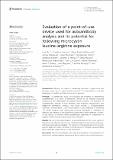Evaluation of a point-of-use device used for autoantibody analysis and its potential for following microcystin leucine-arginine exposure

View/
Date
2024-02-09Author
Ma, Hui
Loscher, Christine
Parle-McDermott, Anne
Fitzgerald, Jenny
Meneely, Julie
Elliott, Christopher
Welten, Richard
Mchau, Geofrey
Makule, Edna
Machunda, Revocatus
Gong, Yun
Kimanya, Martin
Crawley, Aoife
Maguire, Ivan
Murphy, Caroline
Kennedy, Richard
Metadata
Show full item recordAbstract
Introduction: Globally, the need for measuring exposure to algal toxins has become urgent due to ever-increasing reports of contamination in sea and freshwater, in shellfish and fish stocks and in aerosols.
Methods: To address this issue, we evaluated the potential of determining autoantibodies to a panel of biomarkers known to be elevated following exposure to the hepatotoxin microcystin leucine-arginine. The presence of autoantibodies, specific to four selected stress-response, metabolomic and chaperone biomarkers, namely, Heat shock protein 1, Triosephosphate isomerase, Peroxiredoxin 1 and Peroxiredoxin 2 was employed in screening 371 serum samples from microcystin-exposed individuals in Tanzania. In addition, the capacity of the LightDeck fluorescence-based detector, a point-of-use device, to monitor these autoantibody responses in comparison to enzyme-linked immunosorbent assay was evaluated.
Results: By using the determination of autoantibodies to this novel panel of biomarkers an altered response was observed following microcystin exposure, with levels generally upregulated. The presence of elevated levels of microcystin leucine-arginine in water, as well as in food sources in Tanzania, may potentially have significant health effects on the population.
Discussion: This novel biomarker panel may have potential for the detection of microcystin leucine-arginine exposure as well as various microcystin exposure-associated cancers (e.g., hepatocellular cancer and colorectal cancer). In addition, the utilisation of the LightDeck point-of-use device proved successful for the rapid analysis of this biomarker panel.
URI
https://doi.org/10.3389/fsens.2024.1302520https://dspace.nm-aist.ac.tz/handle/20.500.12479/2677
